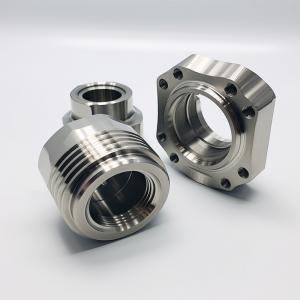
Add to Cart
In traditional machining, a skilled machinist manually operates a machine to remove or shape
metal based on specifications provided by designers and engineers, typically conveyed through
an engineering drawing or blueprint.
This process involves the use of turn wheels, dials, switches, chucks, vices, and various cutting
tools made of materials such as hardened steel, carbide, and industrial diamond.
Measurement instruments are then utilized to ensure the accuracy of all dimensions.
In contrast to this manual approach, CNC machining performs the same metal cutting, drilling,
milling, boring, grinding, and other metal forming and removal functions, but it relies on
computer numerical control instead of manual operation by a machinist.
It is automated, driven by code, and developed by programmers, offering precision consistently
from the first cut to the 500th. While traditional machining still has a place, CNC machining,
prevalent in digital manufacturing and low-volume production, allows for easy revisions and
alterations for modifications and different materials.
Product Details
CNC turning is a versatile machining process that can effectively work with various materials.
These materials include metals like aluminum, steel, brass, and titanium, as well as plastics
such as acrylic, nylon, and polycarbonate.
| Common Materials | |
| Name | Description |
| Aluminum | High machinability and ductility, good strength-to-weight ratio. |
| Stainless steel | High tensile strength, corrosion and temperature resistant. |
| Mild steel | High machinability and weldability, high stiffness. |
| Brass | Low friction, excellent electrical conductivity, golden appearance. |
| Copper | Excellent thermal and electrical conductivity. |
| Titanium | Excellent strength to weight ratio, used in aerospace, automotive and medical industries. |
| POM | High stiffness, high accuracy, low friction, easy to machine. |
| ABS | Common thermoplastic, impact resistant, easy to machine. |
| Nylon | Excellent mechanical properties, thermal, chemical and abrasion resistant. |



| CNC Turning Tolerances | ||
| Limits for nominal size | Plastics | Metals |
| 0.5mm* to 3mm | ±0.1mm | ±0.05mm |
| Over 3mm to 6mm | ±0.1mm | ±0.05mm |
| Over 6mm to 30mm | ±0.2mm | ±0.10mm |
| Over 30mm to 120mm | ±0.3mm | ±0.15mm |
| Over 120mm to 400mm | ±0.5mm | ±0.20mm |
| Over 400mm to 1000mm | ±0.8mm | ±0.30mm |
| Over 1000mm to 2000mm | ±1.2mm | ±0.50mm |
| Over 2000mm to 4000mm | ±2.0mm | |
| *Please clearly indicate tolerances for nominal sizes below 0.5mm on your technical drawing. | ||
Typical Applications of CNC Turning
The applications of CNC machining are virtually limitless, offering a myriad of possibilities across
various industries. One notable application is in the woodworking sector, where CNC machines
streamline the production of wooden furniture, saving time and reducing costs.
Complex geometries that would traditionally require a skilled woodworker can now be achieved
efficiently through CNC machining. In lettering and engraving systems, CNC technology is utilized
for marking patterns or text onto surfaces, serving both artistic and serialized part needs.
The electrical industry benefits from CNC machining for tasks such as creating component
mounting holes in printed circuit boards and machining heat sinks for heat-generating electrical
components.
Precision equipment for the pharmaceutical industry, including metering pumps, ingredient
-dispensing nozzles, and packaging components, is also manufactured using CNC machines.
Even in the fast-moving consumer goods sector, CNC machining plays a vital role in producing
custom material-handling machinery for the food and beverage industry, as well as contributing
to the fabrication of injection-molded plastic molds used in food packaging.

Company Profile


FAQ's
1. Can make design drawings for me?
Regrettably, we don't offer a dedicated product design service. Nevertheless, we conduct
thorough Design for Manufacturing reviews for all approved orders.
Our collaborative approach involves assisting clients in refining their 2D and 3D drawings to
enhance manufacturability, resolve design conflicts, and cut down on production costs.
Explore our recommendations for preparing CAD drawings for manufacturing.
2. How much import duty will I need to pay for my goods?
The import duty for your goods is not universally fixed, and its calculation depends on several
factors. In Australia, new CHAFTA regulations facilitate a phased introduction of duty-free imports.
Import duties vary widely and are contingent upon the nature of the imported goods.
Internationally, the majority of countries follow the Harmonized System (HS) codes, classifying a
broad spectrum of commercial trade goods.
3. Do you offer reverse engineering services or suggest cost saving measures?
In addition to providing reverse engineering services, we excel in extracting design and
engineering details from diverse manufactured components. Our support extends to assisting in
the design process, recommending optimal raw materials, and advising on efficient machining and
finishing strategies.
Our approach considers the end-use of the part, enabling us to pinpoint subtle design modifications,
material alterations, or tolerance adjustments that can lead to cost savings without sacrificing
quality or performance.
4. Do you offer other services, like finishing, assembly, packaging, and logistical support?
Our range of services extends seamlessly from finishing operations to logistical support, providing
a comprehensive solution for the swift and cost-effective production of your parts.
With capabilities covering anodizing, plating, grinding, finishing, assembly, warehousing, packaging,
and just-in-time delivery, we aim to deliver a hassle-free, one-stop production process.
This approach allows you to channel your efforts into your business priorities while enjoying time
and cost savings.